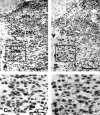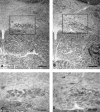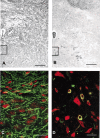Proteolipid protein gene mutation induces altered ventilatory response to hypoxia in the myelin-deficient rat
- PMID: 12657685
- PMCID: PMC6742015
- DOI: 10.1523/JNEUROSCI.23-06-02265.2003
Proteolipid protein gene mutation induces altered ventilatory response to hypoxia in the myelin-deficient rat
Abstract
Pelizaeus Merzbacher disease is an X-linked dysmyelinating disorder of the CNS, resulting from mutations in the proteolipid protein (PLP) gene. An animal model for this disorder, the myelin-deficient (MD) rat, carries a point mutation in the PLP gene and exhibits a phenotype similar to the fatal, connatal disease, including extensive dysmyelination, tremors, ataxia, and death at approximately postnatal day 21 (P21). We postulated that early death might result from disruption of myelinated neural pathways in the caudal brainstem and altered ventilatory response to oxygen deprivation or hypercapnic stimulus. Using barometric plethysmography to measure respiratory function, we found that the MD rat develops lethal hypoxic depression of breathing at P21, but hypercapnic ventilatory response is normal. Histologic examination of the caudal brainstem in the MD rat at this age showed extensive dysmyelination and downregulation of NMDA and to a lesser extent GABA(A) receptors on neurons in the nucleus tractus solitarius, hypoglossal nucleus, and dorsal motor nucleus of the vagus. Unexpectedly, immunoreactive PLP/DM20 was detected in neurons in the caudal brainstem. Not all biosynthetic functions and structural elements were altered in these neurons, because phosphorylated and nonphosphorylated neurofilament and choline acetyltransferase expression were comparable between MD and wild-type rats. These findings suggest that PLP is expressed in neurons in the developing brainstem and that PLP gene mutation can selectively disrupt central processing of afferent neural input from peripheral chemoreceptors, leaving the central chemosensory system for hypercapnia intact.
Figures










Similar articles
-
Processing of PLP in a model of Pelizaeus-Merzbacher disease/SPG2 due to the rumpshaker mutation.Glia. 2006 May;53(7):715-22. doi: 10.1002/glia.20325. Glia. 2006. PMID: 16506223
-
PLP overexpression perturbs myelin protein composition and myelination in a mouse model of Pelizaeus-Merzbacher disease.Glia. 2007 Mar;55(4):341-51. doi: 10.1002/glia.20465. Glia. 2007. PMID: 17133418
-
PLP/DM20 expression and turnover in a transgenic mouse model of Pelizaeus-Merzbacher disease.Glia. 2010 Nov 1;58(14):1727-38. doi: 10.1002/glia.21043. Glia. 2010. PMID: 20629189
-
Pelizaeus-Merzbacher disease.J Neuropathol Exp Neurol. 2002 Sep;61(9):747-59. doi: 10.1093/jnen/61.9.747. J Neuropathol Exp Neurol. 2002. PMID: 12230321 Review.
-
The PLP mutants from mouse to man.J Neurol Sci. 2005 Feb 15;228(2):204-5. doi: 10.1016/j.jns.2004.10.011. Epub 2004 Nov 24. J Neurol Sci. 2005. PMID: 15694207 Review. No abstract available.
Cited by
-
Mutation in the myelin proteolipid protein gene alters BK and SK channel function in the caudal medulla.Respir Physiol Neurobiol. 2009 Dec 31;169(3):303-14. doi: 10.1016/j.resp.2009.09.013. Epub 2009 Oct 4. Respir Physiol Neurobiol. 2009. PMID: 19808102 Free PMC article.
-
The multiple roles of myelin protein genes during the development of the oligodendrocyte.ASN Neuro. 2010 Feb 1;2(1):e00027. doi: 10.1042/AN20090051. ASN Neuro. 2010. PMID: 20017732 Free PMC article. Review.
-
Mutation of Proteolipid Protein 1 Gene: From Severe Hypomyelinating Leukodystrophy to Inherited Spastic Paraplegia.Biomedicines. 2022 Jul 15;10(7):1709. doi: 10.3390/biomedicines10071709. Biomedicines. 2022. PMID: 35885014 Free PMC article. Review.
-
Expression of a myelin proteolipid protein (Plp)-lacZ transgene is reduced in both the CNS and PNS of Plp(jp) mice.Neurochem Res. 2007 Feb;32(2):343-51. doi: 10.1007/s11064-006-9202-z. Epub 2006 Dec 27. Neurochem Res. 2007. PMID: 17191136 Free PMC article.
-
Plp1 gene duplication inhibits airway responsiveness and induces lung inflammation.Pulm Pharmacol Ther. 2015 Feb;30:22-31. doi: 10.1016/j.pupt.2014.10.004. Epub 2014 Nov 4. Pulm Pharmacol Ther. 2015. PMID: 25445931 Free PMC article.
References
-
- Ang RC, Hoop B, Kazemi H. Role of glutamate as the central neurotransmitter in the hypoxic ventilatory response. J Appl Physiol. 1992;72:1480–1487. - PubMed
-
- Boulloche J, Aicardi J. Pelizaeus-Merzbacher disease: clinical and nosological study. J Child Neurol. 1986;1:233–239. - PubMed
-
- Campagnoni CW, Garbay B, Micevych P, Pribyl T, Kampf K, Handley VW, Campagnoni AT. DM20 mRNA splice products of the myelin proteolipid protein gene are expressed in the murine heart. J Neurosci Res. 1992;33:148–155. - PubMed
-
- Ciriello J, Hrycyshyn AW, Calaresu FR. Horseradish peroxidase study of brain stem projections of carotid sinus and aortic depressor nerves in the cat. J Auton Nerv Syst. 1981;4:43–61. - PubMed
Publication types
MeSH terms
Substances
Grants and funding
LinkOut - more resources
Full Text Sources
Research Materials
